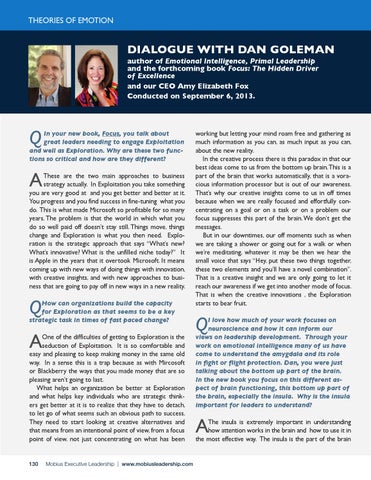THEORIES OF EMOTION
DIALOGUE WITH DAN GOLEMAN author of Emotional Intelligence, Primal Leadership and the forthcoming book Focus: The Hidden Driver of Excellence and our CEO Amy Elizabeth Fox Conducted on September 6, 2013.
Q
In your new book, Focus, you talk about great leaders needing to engage Exploitation and well as Exploration. Why are these two functions so critical and how are they different?
A
These are the two main approaches to business strategy actually. In Exploitation you take something you are very good at and you get better and better at it. You progress and you find success in fine-tuning what you do. This is what made Microsoft so profitable for so many years. The problem is that the world in which what you do so well paid off doesn’t stay still. Things move, things change and Exploration is what you then need. Exploration is the strategic approach that says “What’s new? What’s innovative? What is the unfilled niche today?” It is Apple in the years that it overtook Microsoft. It means coming up with new ways of doing things with innovation, with creative insights, and with new approaches to business that are going to pay off in new ways in a new reality.
Q
How can organizations build the capacity for Exploration as that seems to be a key strategic task in times of fast paced change?
A
One of the difficulties of getting to Exploration is the seduction of Exploitation. It is so comfortable and easy and pleasing to keep making money in the same old way. In a sense this is a trap because as with Mircosoft or Blackberry the ways that you made money that are so pleasing aren’t going to last. What helps an organization be better at Exploration and what helps key individuals who are strategic thinkers get better at it is to realize that they have to detach, to let go of what seems such an obvious path to success. They need to start looking at creative alternatives and that means from an intentional point of view, from a focus point of view, not just concentrating on what has been
130
Mobius Executive Leadership | www.mobiusleadership.com
working but letting your mind roam free and gathering as much information as you can, as much input as you can, about the new reality. In the creative process there is this paradox in that our best ideas come to us from the bottom up brain. This is a part of the brain that works automatically, that is a voracious information processor but is out of our awareness. That’s why our creative insights come to us in off times because when we are really focused and effortfully concentrating on a goal or on a task or on a problem our focus suppresses this part of the brain. We don’t get the messages. But in our downtimes, our off moments such as when we are taking a shower or going out for a walk or when we’re meditating, whatever it may be then we hear the small voice that says “Hey, put these two things together, these two elements and you’ll have a novel combination”. That is a creative insight and we are only going to let it reach our awareness if we get into another mode of focus. That is when the creative innovations , the Exploration starts to bear fruit.
Q
I love how much of your work focuses on neuroscience and how it can inform our views on leadership development. Through your work on emotional intelligence many of us have come to understand the amygdala and its role in fight or flight protection. Dan, you were just talking about the bottom up part of the brain. In the new book you focus on this different aspect of brain functioning, this bottom up part of the brain, especially the insula. Why is the insula important for leaders to understand?
A
The insula is extremely important in understanding how attention works in the brain and how to use it in the most effective way. The insula is the part of the brain

